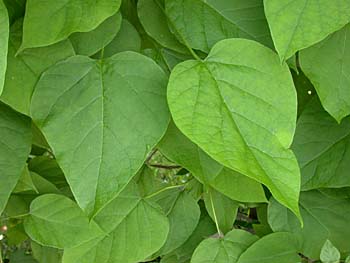Northern Catalpa Tree (Catalpa speciosa)
Category: Deciduous Trees

Sientific name for Northern Catalpa Tree "Catalpa speciosa".
The Northern Catalpa tree is a deciduous tree which is medium to large in size and can typically grow, under good conditions, to a height of about forty to seventy feet tall. It can less frequently grow to a height of one hundred feet tall. The tree can typically grow along bluff bases and in both low and upland woods and along streams, The Northern Catalpa tree has its native being to a relatively small area which extends from northeastern Arkansas, western Tennessee and the lowlands of southeastern Missouri north to southern Indiana and southern Illinois located in Missouri.
The tree has a narrow- oval to open- rounded irregular crown. The very big establishes pointed tipped leaves that are broad ovate-oblong shaped with a rounded heart-shaped bottom. They are "whorled" which means (there are 3 leaves and buds at a single node, circular flower or leave arrangement of like parts). The leaves can be anywhere from 3 to 8 inches (7.6 to 20.3 cm) wide and 6 to 12 inches (15.2 to 30.4 cm) long. The leaves are green with little soft hairs on the bottom. The petiole meaning "the stalk that joins a leaf to a stem" will be 4 to 6 inches (10 to 15.2 cm) long.
The tree has well established foliage green laves. Its leaves have yellow green to light green color above with a densely pubescent color below. Its foliage can turn yellow in color at the time of fall. The tree has blossoms that produce bell-shaped, orchid-like flowers that are white in color. Its flowers can grow to a height of approximately two inches with their yellow and purple inner spotting appearing in panicles in late spring. The catalpa tree has long green seedpods which are slender and are about twelve to twenty two inches long. These seed pods, which are produced every two to three years, mature to a dark brown color. After their fall, they usually split open to give rise seeds. The tree has a bark which is prominently ridged, fissured and pale gray-brown in color.
This tree can easily establish in a well drained soils with partly shade to full sun. However, it can tolerate both dry and wet soil conditions and seasonal flooding.
A symmetrically rounded mature, Northern Catalpa tree can be spectacular and very attractive especially in spring when its foliage is young and flowers in bloom. However, it is a relatively coarse tree. "Fear of trees Dendrophobia".

 Back To Category Deciduous Trees
Back To Category Deciduous Trees